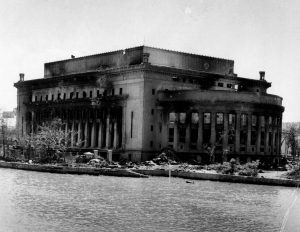Could the destruction of the old city of Manila and the deaths of over 100,000 Filipino civilians have been avoided in February 1945? The question vexed planners at the time, and has been debated extensively in the years since.
First and foremost, the Imperial Japanese Army and the Imperial Japanese Navy could have declared Manila an open city and retreated to defensive lines that would not have needlessly endangered the safety of the civilian population and the city’s historical heritage.
During the battle, Japanese forces could have surrendered rather than fighting until the end; indeed, American leaflets and loudspeakers encouraged them to do so. Instead, Japanese forces continued fighting out of a desire to inflict maximum casualties on American forces, a tactical posture in line with Japan’s strategic effort to drag the United States to the negotiating table by maximizing costs even in militarily hopeless situations. Even granting the decision to defend the city, Japanese commanders could have imposed better discipline upon their men, and emphasized an ethos of civilian protection rather than a culture of mass reprisal against guerilla activity. Civilian deaths were overwhelmingly the responsibility of Japanese military decision-making.
Yet questions about U.S. decision-making also linger. Was it necessary to storm Manila during the final year of a war in which the seizure of the city would play no significant decisive role? A lack of sea and air transport meant that Japanese forces could not relocate to more critical parts of the empire. The supply situation also meant that the Japanese forces posed no significant threat to U.S. control of Luzon, although Manila Bay remained an important strategic asset. MacArthur and other American officials clearly felt obligated by both reputation and honor to liberate the Philippines. However, this obligation did not obviously extend to contemplation of the destruction that such a liberation would incur, although concern that Japanese depredations would devastate the country were widely shared. The American advance was also driven by legitimate concerns over Japanese treatment of the city and of Japanese prisoner of war camps. Credible reports of executions of American and Filipino POWs and of Japanese reprisals against Filipino civilians were well-known to the U.S. Army. Moreover, Japanese forces had no way to ensure that the civilian population of Manila could remain fed for the remainder of the war.
One enormous question involves the choice of the Philippines over Formosa as a target for invasion in late 1944. U.S. planners had debated seizing Formosa instead as preparation for a drive on the Japanese home islands, but operational considerations and the sense of obligation to the Philippines carried the day. That said, Formosa was also densely populated, and it is difficult to argue that the dynamics which held in the Philippines and which enabled the massacre could not have applied to, for example, Taipei, although Formosans were not nearly as hostile to the Japanese as Filipinos.
Having invaded the Philippines and especially Luzon, however, it would have been very difficult for the United States Army to avoid seizing Manila. Manila Bay offered a deep water port useful for staging the invasions of Iwo Jima, Okinawa, and eventually Kyushu. Leaving Manila under Japanese control might have enabled massacres, and the Japanese obviously could not ensure the feeding of the city.
Tactical factors also intruded. The extensive use of artillery by the U.S. Army undoubtedly saved many American lives, but it also helped ensure heavy civilian casualties in Japanese-controlled areas, as well as the destruction of the historical core of the city. MacArthur’s refusal to allow the aerial bombing of Japanese controlled areas probably extended the battle, and artillery inflicted much of the same damage anyway.
It is true to say that different American choices might have led to different operational realities. The U.S. could have spared Manila by invading Formosa, but that also might have resulted in great destruction. Primarily, however, the responsibility of the massacre rests with the Japanese military. Indeed, the nature of Japan’s responsibility became legally consequential in the years after the war, and has helped guide legal thinking in the years since.
































